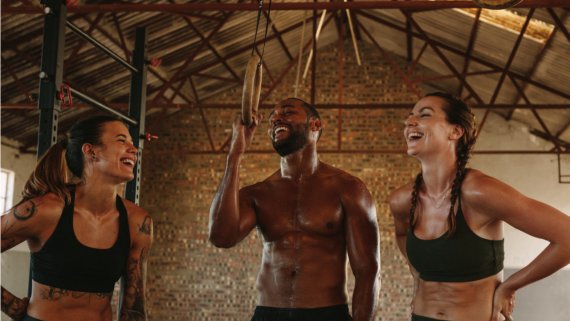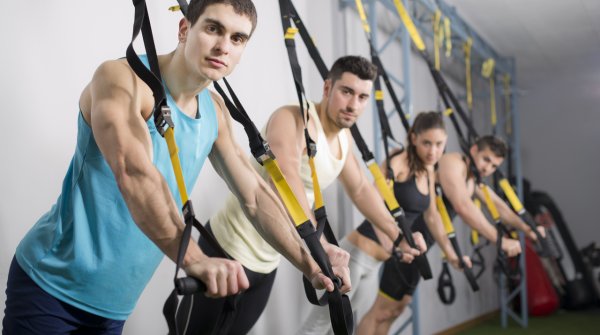- What is Tabata?
- Tabata training - workout at home
- Tabata exercises for beginners
- Tabata exercises for advanced
- Tabata exercises for professionals
- Tabata Exercises: Push-up, Burpee & Mountain Climber
- Tabata exercises for leg and back muscles
- Tabata exercises for leg muscles
- Tabata exercises - what you should pay attention to
- How do you warm up properly before a Tabata exercises for home?
- Do Tabata exercises replace a full workout?
- How often should you change your workout plan?
- What is the difference between a Tabata workout and HIIT?
- What is a Tabata workout good for?
- Can you build muscle with Tabata exercises?
Tabata exercises are fantastic because they provide short but high-intensity workouts that effectively increase endurance, boost fat burning, strengthen muscles, and help improve fitness in a motivating and varied way. Just four minutes a day is enough to extremely boost metabolism, increase fitness and at the same time reduce body fat.
However, if you think you can get your dream body with a convenient shortcut, you're wrong. Tabata is so successful in terms of effective fat burning precisely because it is anything but convenient. The shortness of the workouts can be explained primarily by their extremely high intensity: 20 seconds of maximum effort - 10 seconds of rest. After a total of eight rounds, you have survived a training session.
*if you don't have a kettlebell at home, you can just take a water bottle instead
It's been ages since your last workout, and you wouldn't exactly call yourself a jock? No problem at all. Only determination and stamina are required. The beginner workout will not overtax you technically and is still highly effective.
Two exercises are enough to push you to the limit: Jumping jacks, or "jumping jacks," and burpees, which involve squatting from a push-up position followed by a stretch jump. Over the course of four minutes, the exercises are always performed in alternation, always following the principle of 20 seconds of power - 10 seconds of rest.
The workout is a full-body workout and is ideal for building up basic fitness. Four units a week should be enough at the beginning. After about three weeks, the body has become accustomed to the load and the program can and should be changed.
If you consider yourself generally fit or have already completed the beginner's workout, the next step follows: The basic condition is there - the next level can come. In order to work the individual muscle groups in a more targeted manner, two more exercises are now added to the program: Squats and push-ups.
For the squat, it is important to keep the upper body as upright as possible, to form a slight hollow back and to bend at least deep enough so that the knees form a 90 degree angle. Since many women have difficulty with the classic push-up, an alternative variation can be used here: Instead of on hands and feet, the exercise is performed on hands and knees.
Start with the well-tried jumping jacks, followed by squats, burpees and push-ups alternating according to the 20 seconds - 10 seconds principle. The workload here can be increased to five to six units per week and after three weeks, a change should be made again.

For all passionate Tabata followers, here comes the pro workout. The fitness is there, the form is on a good way - now it's time for the fine tuning. In addition to squats and push-ups, two other exercises from the world of strength sports are added to activate the muscles: pull-ups and lunges.
From now on, the sequence of exercises is squats, pull-ups, lunges, push-ups: both squats and lunges target the muscles in the legs, buttocks and torso. For lunges, simply alternate between taking a step forward and squatting.
Push-ups and chin-ups are excellent exercises to activate the entire upper body. Alternatively, those who can't do pull-ups can switch to jumping chin-ups. Simply jump up to the bar, take advantage of the momentum to pull yourself up and release in a controlled manner.
Of course, the Tabata principle also applies to the professional workout - six units per week should now be no problem. To ensure that the necessary recovery is not neglected, the cycle can be started again from the beginning after another three weeks.
We start with the classic push-ups, which primarily activate the chest, shoulders and triceps. This is followed by a full-body exercise known as the burpee or squat jump, in which you squat down from the push-up position and then jump off with your arms stretched upwards.
In the Mountain Climber - round three - the starting position is also the push-up position. Now bring the bent legs forward alternately so that the knees almost touch the outer elbows. Finally, the crunches in the final round target the abdominal muscles once again - lie flat on your back, bend your legs, position your hands in the area of your temples and move your upper body in the direction of your knees.
The second workout focuses on the leg and back muscles. We start with an absolute fat burner, namely the squat. Form a slight hollow back, keep the upper body upright and go down as low as possible. Hardly any other exercise is as effective when it comes to burning fat and increasing fitness.
Lunges follow: Take one step forward and now squat. As with the squat, this exercise particularly targets the quadriceps and gluteus, or buttock muscle. Then the back and biceps are activated with pull-ups.
Jumping jacks follow. With this classic exercise, you can really step on the gas again and challenge your body holistically.
The first two workouts each contain four different exercises. With a 20-second load and 10-second rest, eight sets are completed in four minutes. Those who have completed all four exercises in the first round can immediately look forward to the second round.
The focus of the third workout is once again increasingly on the leg muscles. And there is a reason for this, because the quadriceps and gluteus are among the largest muscle groups in the body. Consequently, a lot of energy is burned during leg training.
The following exercises are available: Spinning, sprinting or jumping rope. After deciding on two exercises, they are always performed in alternation: Four rounds of sprinting and four rounds of rope jumping, this is how a possible composition could look like.
With one Tabata workout per day you are already well positioned. However, in order to address all muscle groups evenly and to have some variety, a different workout should be selected every day. If you go full steam ahead six times a week, you can also take a day off to regenerate your muscles with a clear conscience.
20 seconds sweating - 10 seconds recovering: That's the principle of Tabata. But what do you have to watch out for in this short workout? First of all, Tabata is not the same as a casual workout on a stepper or treadmill - the term High Intensity Interval Training (HIIT) is not a coincidence. HIIT, is no coincidence.
Above all, the cardiovascular system is extremely challenged during Tabata. In order to give full intensity and to be able to go to the individual limits, therefore, one thing is important above all: robust health. Anyone who is struggling with physical limitations should definitely seek the advice of a doctor beforehand.
Once you've conquered your inner weakness and banished the fear of a nasty muscle a che, you should set realistic goals. Our body does not change overnight and the path to the desired feel-good figure will take some time.
To stay motivated on the ball, it is important to select suitable and, above all, varied exercises. It is also advisable to document your personal performance in a training diary.
The following applies to all workouts: Before getting down to business, warm up properly! An additional five to ten minutes should be allowed for this.
In general, warming up before a workout is important to minimize the risk of injury. A Tabata workout uses a wide variety of muscle groups, so the whole body should be warmed up. Possible exercises include the following:
- Jumping Jacks
- Arms and wrists circles
- Knees circling
- Pulling legs back and stretching
Warming up the knees is especially important because burpees can cause joint problems that can be avoided by proper warm-up. Just 30 seconds per warm-up exercise is enough to greatly minimize the risk of injury.
Still have questions about Tabata and HIIT? Here you will find the answer to the most frequently asked questions!
Yes and no. With a Tabata workout, you burn a lot of fat in a very short time and effectively work on your endurance. However, the World Health Organization (WHO) recommends 2.5 hours of exercise per week, or 75 minutes at high intensity. Six Tabata sessions of four minutes each is just 24 minutes, but a Tabata workout is also more intense than classic HIIT.
For steady progress, it's important that your workout plan keeps changing and adapting to your fitness level. Every three weeks, the exercises from a Tabata workout should be adjusted to provide new muscle stimulation.

A Tabata workout is more intense than comparable bodyweight workouts. The target heart rate for this workout method is 100 percent, while the target heart rate for a HIIT workout is between 80 and 95 percent. However, the intervals in HIIT workouts are longer, as are the rests.
Tabata exercises have many positive effects on your body. A Tabata workout helps you lose weight, it strengthens your muscles and supports your cardiovascular system. In addition, interval training has other benefits:
- improves aerobic and anaerobic endurance
- promotes fat burning and weight loss
- contributes to muscle building
- saves time (only 4 minutes per training session)
- increases overall fitness and performance
- motivating and varied
Yes, you can definitely build muscle with Tabata exercises, especially if you were previously untrained or had little experience with intense exercise. Although Tabata is mainly known as a high-intensity cardio workout, it can also lead to some muscle hypertrophy as different muscle groups are used during the exercises. Tabata helps with definition and works a wide variety of muscle groups. However, you can't build muscle as effectively with this training method as you can with dumbbells.
 Know-HowThe 11 Best TRX Exercises
Know-HowThe 11 Best TRX Exercises
- ISPO awards
- Mountain sports
- Bike
- Design
- Retail
- Fitness
- Health
- ISPO Job Market
- ISPO Munich
- ISPO Shanghai
- Running
- Brands
- Sustainability
- Olympia
- OutDoor
- Promotion
- Sports Business
- ISPO Textrends
- Triathlon
- Water sports
- Winter sports
- eSports
- SportsTech
- OutDoor by ISPO
- Heroes
- Transformation
- Sport Fashion
- Urban Culture
- Challenges of a CEO
- Trade fairs
- Sports
- Find the Balance
- Product reviews
- Newsletter Exclusive Area
- Magazine



